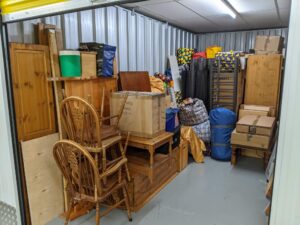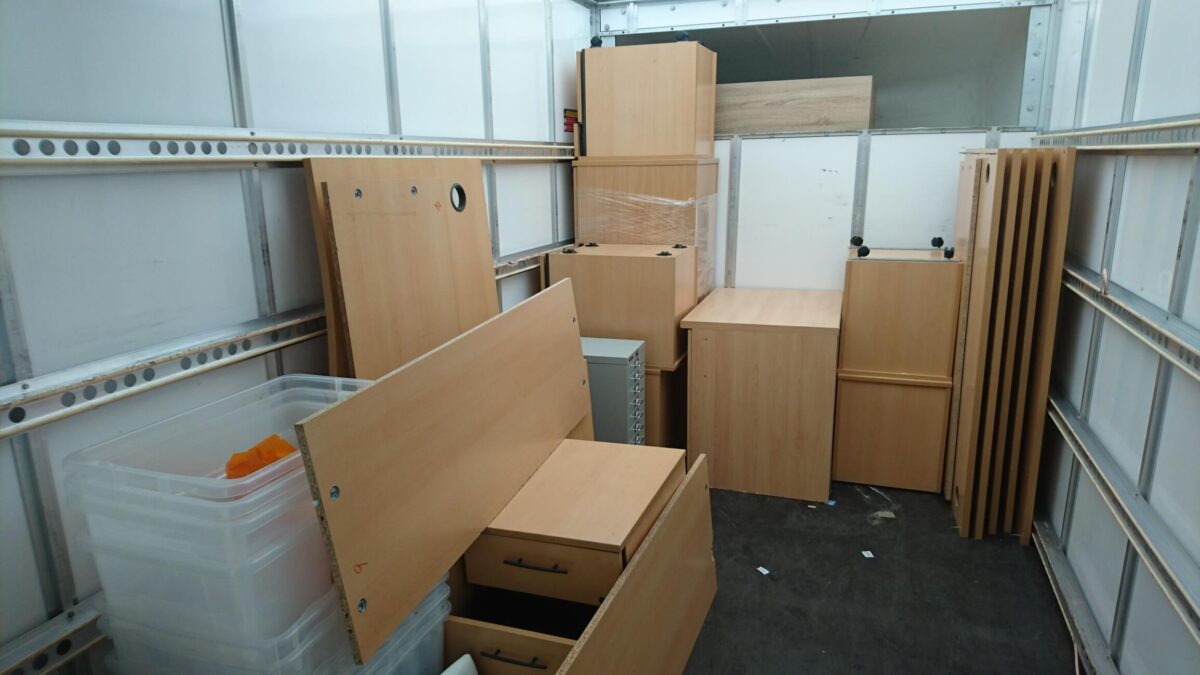Self-storage can be a lifesaver when it comes to decluttering your home, downsizing, or temporarily moving to a new place. However, ensuring your furniture is properly prepared for storage is crucial to keep it in excellent condition. In this guide, we’ll walk you through the steps and furniture storage tips to prepare your furniture for self-storage, ensuring that it remains safe, clean, and well-preserved during storage.
Assessing the Storage Needs
Assessing the storage needs is a critical first step in preparing furniture for self-storage. This phase comprehensively evaluates the furniture items you intend to store, considering various factors to ensure a smooth and efficient storage experience.
1. Quantity and Types of Furniture – Begin by carefully evaluating the amount and variety of furniture you intend to store. Take note of the different types of items, including large pieces, delicate surfaces, and any unique features that may require special attention. This assessment is the foundation for making informed decisions throughout the storage preparation.
2. Determining Storage Unit Size – Once you clearly understand your furniture inventory, consider the storage unit size needed. Avoid unnecessary expenses and optimize space by selecting a unit that accommodates your furniture comfortably. This step ensures that items are neither cramped nor underutilized space, promoting better preservation and accessibility.
3. Specific Preparations for Each Item – Recognize that different pieces of furniture may require specific preparations to ensure their safety and preservation during storage. Identify items that need disassembly, delicate surfaces that require extra protection, and any unique storage considerations. Tailor your preparations based on the specific needs of each furniture piece to mitigate potential damage.
4. Anticipating Long-Term Storage Challenges – Consider the duration of storage and anticipate potential challenges that may arise over time. Factors like humidity, temperature changes, and pest control become more critical for longer storage periods. This consideration influences the choice of storage facility, the materials used for wrapping, and the overall strategy for maintaining furniture in optimal condition throughout its stay in storage.
5. Budgeting and Cost-Efficiency – Assessing your storage needs extends to budgeting and cost considerations. Understand the financial aspect of securing an appropriately sized storage unit and acquiring necessary packing materials. By aligning your storage preparations with your budget, you can make informed decisions that balance the protection of your furniture with cost efficiency.
Thoroughly evaluate your storage needs, considering the need to dismantle furniture, protect legs with cardboard, and use a vacuum or cleaner for fabric items. Incorporate pest control measures, like cloth soaked in pest control solutions, to prevent mold and deter pests. This comprehensive approach ensures that you are financially prepared for a well-organized and effective furniture storage plan, addressing every aspect, from the cleanliness of your items to the location and protection of your storage space.
Selecting the Right Storage Facility
Selecting the right storage facility is a critical decision that can significantly impact the safety and condition of your belongings. Here are five considerations to keep in mind when choosing a storage facility:
1. Location and Accessibility
Consider the location of the storage facility in relation to your home or workplace. Opt for a facility that is conveniently located to reduce travel time and expenses. Additionally, assess the accessibility of the facility, including the ease of reaching your storage unit within the facility. Look for features like wide driveways and well-maintained pathways that facilitate smooth access, especially if you plan on retrieving items frequently.
2. Security Measures
The security of the storage facility should be a top priority. Inquire about the security measures in place, such as surveillance cameras, gated access, and on-site security personnel. A well-lit facility with robust security features helps deter theft and ensures a safer environment for your belongings. Don’t hesitate to ask about the facility’s track record in terms of security incidents to gauge its reliability.
3. Climate Control
Consider the climate control options available at the storage facility. There are several benefits of climate-controlled storage units, which are essential for protecting items sensitive to temperature and humidity fluctuations, such as wooden furniture, electronics, and delicate fabrics. If you live in an area with extreme temperatures or high humidity, investing in a climate-controlled unit can prevent damage from mold, mildew, and warping.
4. Unit Size and Features
Evaluate your storage needs and choose a facility that offers a variety of unit sizes to accommodate your belongings adequately. Some facilities provide additional features like shelving, electricity, or drive-up access. Carefully assess whether these amenities align with your storage requirements and preferences. A well-organized and properly sized unit can optimize space utilization and ease the retrieval process.
5. Reviews and Reputation
Before finalizing your decision, research the facility’s reputation by reading customer reviews and testimonials. Online reviews can provide valuable insights into the experiences of others who have used the storage facility. Look for feedback regarding cleanliness, customer service, security, and any issues with pests or climate control. A facility with positive reviews is more likely to provide a reliable and satisfactory storage experience.
Selecting the right storage facility involves a thorough examination of its location, security measures, climate control options, unit sizes, and overall reputation. By considering these factors, you can make an informed decision that ensures the safety, accessibility, and proper care of your belongings during their time in storage.

Taking Inventory of Furniture Items
Creating a detailed inventory is a fundamental step in preparing furniture for self-storage. By meticulously listing all the furniture items slated for storage, you establish a structured approach that not only streamlines the storage process but also acts as a valuable reference tool during retrieval. Record the dimensions and current condition of each item, providing you with essential information for planning and optimizing storage space.
This inventory not only facilitates a systematic arrangement within the storage unit but also becomes an indispensable guide, ensuring that when the time comes to retrieve specific pieces, you have a clear and accurate record to expedite the process. In essence, the comprehensive inventory serves as a practical and strategic tool, enhancing the overall efficiency and effectiveness of your Self-storage experience.
Disassembling Large Furniture Pieces
One crucial step in getting your items ready for self-storage is to disassemble the large furniture to better organize your storage space. This not only helps maximize storage space but also adds a layer of security against potential damage during transportation and while in storage. Big items like bed frames, tables, or bookshelves often have complex structures prone to scratches or dents. Carefully disassembling them not only reduces their size but also creates a more secure and organized arrangement.
Ensure you keep tabs on all screws, nuts, and bolts by organizing them in labeled bags or containers, making the eventual reassembly a smooth process when you retrieve your furniture. This extra attention to disassembling and organizing significantly contributes to the overall protection and longevity of your furniture during its time in self-storage.
Cleaning and Dusting the Furniture
Maintaining the longevity and condition of your furniture during storage is a crucial process that begins with a thorough cleaning and dusting routine. The accumulation of dust and grime over time can lead to potential damage, making it essential to use suitable cleaning agents tailored to the specific materials of each piece.
Initiate the cleaning process by wiping down surfaces, ensuring the removal of visible dust and dirt. If dealing with fabric-covered furniture, consider employing a vacuum or steam cleaning to eliminate hidden particles. Wooden surfaces may benefit from the use of a gentle wood cleaner, while glass or metal components may require specialized cleaning solutions.
The importance of ensuring your furniture is in its optimal condition before storage cannot be overstated. Clean surfaces not only contribute to the overall appearance but also act as a preventive measure against stains, discoloration, or deterioration during the storage period. This extra step sets the stage for a successful storage experience, allowing you to retrieve your furniture in the same pristine condition as it was when initially stored.
Wrapping Furniture with Protective Materials
Preserving the durability and flawless state of your furniture during its time in storage is a pivotal undertaking. An essential step in this process involves enveloping your items in protective materials to shield them from potential harm, such as scratches, dents, and other forms of damage. The choice of protective materials depends on the nature of your furniture, with diverse options available, including furniture blankets, bubble wrap, and plastic wrap.
Furniture blankets, offering a soft and cushioned layer, prove ideal for safeguarding items with delicate finishes, such as wood furniture and upholstery. Bubble wrap, characterized by its air-filled pockets, excels in shock absorption, making it a suitable choice for protecting fragile surfaces like glass or polished wood. Meanwhile, plastic wrap serves as a secure and tight layer, effectively preventing the infiltration of dust and moisture into your furniture. To further protect your furniture from potential scratches and damage during self storage, furniture covers are essential as they provide an added layer of cushioning and safeguard against accidental bumps or impacts.
This extra layer of protection becomes particularly crucial when dealing with delicate surfaces prone to scratches, such as polished wood or glass. These materials demand additional care to uphold their pristine appearance. By employing the appropriate protective wrapping, you establish a dependable barrier against potential damages. This ensures that your furniture emerges from its stint in storage in the same impeccable condition as when you meticulously prepared it for its storage journey.
Choosing Appropriate Storage Containers
Selecting the right storage containers is crucial for preserving the structure of your furniture. The chosen containers act as guardians, shielding your items from potential damage during storage. It’s vital to invest in durable boxes or containers that can withstand the weight and pressure exerted by the items they hold. This guarantees that the containers maintain their shape and strength, preventing any compromise to the furniture within.
For smaller accessories or loose parts accompanying your furniture, consider using zip-lock bags or small containers. This approach offers a dual advantage, securely confining items and facilitating organization. By compartmentalizing smaller components, you not only eliminate the risk of misplacement but also ensure a systematic and efficient unpacking process when you retrieve your furniture. Paying attention to container selection significantly contributes to the overall success of your storage endeavor, providing protection for your furniture throughout its stay.

Organizing and Labeling Furniture Items
Efficient organization plays a pivotal role in ensuring a smooth and stress-free storage experience. When getting your furniture ready for storage, it’s crucial to strategically arrange your items within the storage unit. Create a logical order that considers the frequency of access, keeping regularly used items towards the front for quick and easy retrieval.
The importance of clear labeling cannot be overstated in this organizational approach. With explicit labels on each box or container, you establish a clear roadmap for effortless retrieval whenever necessary. This careful labeling not only saves time but also reduces the effort needed during the unpacking process. In essence, a well-organized storage unit guarantees that your belongings, including cushions, tape, moving blankets, storage boxes, furniture covers, wood furniture, couches, upholstery, and more, are easily accessible, promoting efficiency and convenience throughout their time in storage.
Securing Fragile Items and Glass Surfaces:
When dealing with delicate items or those with glass surfaces, it’s crucial to prioritize their protection. To ensure their safety, provide extra care by adding padding or bubble wrap to fragile items. This additional layer cushions, absorbing shocks and preventing potential breakage. For items with glass surfaces, consider using specialized glass protectors or packing methods that minimize the risk of chips or cracks during transportation and storage. These precautions guarantee a safer journey and storage experience for your fragile belongings. To further ensure the safety and organization of your furniture while in self-storage, it is crucial to label each item properly with its corresponding contents and any special handling instructions.
Storing Furniture Safely and Efficiently
When arranging your furniture in a storage unit, it’s crucial to focus on both safety and efficiency. Elevate your items off the floor using pallets or boards to prevent moisture absorption, which can be particularly damaging to wood furniture. Creating aisles within the unit ensures easy access to all items, eliminating the need to shuffle through stacks to find what you need.
Strategically stack lighter items on top of heavier ones, keeping in mind the weight limits of the storage unit. This not only maximizes space but also minimizes the risk of damage to more delicate items. By thoughtfully organizing the storage space, you optimize efficiency, making it simpler to retrieve items when needed.
This method not only safeguards your furniture from potential harm but also ensures a well-organized and accessible storage space for the duration of its stay.
Frequently Asked Questions
Here are some FAQs about self-storage units:
Q. What materials can I use to wrap and protect my furniture?
You can use various materials to wrap and protect your furniture, including furniture blankets, bubble wrap, plastic wrap, and drop cloths. These materials provide a protective layer, preventing scratches, dents, and other potential damage during storage or transit.
Q. How should I label my furniture when storing it?
When labeling your furniture for storage, use clear and descriptive labels on each item or box. Include details like the contents, room of origin, and any special instructions for handling. This makes it easy to locate specific pieces when needed and ensures a smoother unpacking process.
Q. Is it necessary to treat wood furniture before storing it?
Yes, it is advisable to treat wood furniture before storing it. Treating wood furniture helps protect it from moisture, pests, and potential damage during storage. Applying a suitable furniture polish or protective coating can preserve the wood’s quality and ensure its longevity in storage.
Q. Are there any restrictions or guidelines for storing antique furniture?
Yes, storing antique furniture often comes with specific guidelines to preserve its condition. Consider climate-controlled storage to prevent damage from temperature and humidity fluctuations. Use protective covers, avoid direct sunlight exposure, and ensure proper cleaning before storage. Additionally, consult with storage facilities for any specific restrictions or recommendations they may have for preserving antique pieces.
Q. What insurance options are available for protecting my furniture in self storage?
Several insurance options are available to protect your furniture in self-storage. Most storage facilities offer insurance options as part of their services. You can also explore third-party insurance providers specializing in storage coverage. It’s essential to review policies carefully, considering factors like coverage limits, types of damage covered, and associated costs. Choose an insurance plan that aligns with the value of your stored furniture and provides comprehensive protection against potential risks.
Q. What measures can I take to prevent mold or mildew on my stored furniture?
To prevent mold or mildew on stored furniture, ensure the storage area is well-ventilated and climate-controlled if possible. Use moisture-absorbing products like silica gel packs and avoid placing furniture directly against walls. Elevate items off the floor using pallets to allow air circulation. Clean and thoroughly dry furniture before storage, and consider placing dehumidifiers in the storage space. Additionally, use furniture covers made of breathable materials to protect against moisture buildup. Regularly inspect and clean stored furniture to catch and address any potential issues early on.
Q. What type of packing supplies should I use for fragile furniture?
For fragile furniture, use packing supplies such as bubble wrap, packing peanuts, and foam padding. Consider specialized glass protectors for items with glass surfaces. Clearly mark fragile items and store them in a secure location within the storage unit to minimize the risk of breakage during storage and transportation.
Q. What precautions should I take when wrapping furniture for self storage?
When wrapping furniture for self-storage, take precautions to prevent scratches, dents, and damage. Use appropriate protective materials like furniture blankets, bubble wrap, or plastic wrap based on the type of furniture. Pay special attention to delicate surfaces, adding extra padding if necessary, and ensure that the wrapping is secure and tight.
Q. What is the best way to disassemble furniture for storage?
The best way to disassemble furniture for storage is to carefully label and store all screws, nuts, and bolts in labeled bags or containers. This ensures an organized and hassle-free reassembly process when retrieving your furniture. If possible, disassemble larger furniture pieces to save space in the storage unit.
Q. What materials should I use to protect my furniture in storage?
To protect your furniture in storage, use materials such as furniture blankets, bubble wrap, plastic wrap, furniture covers, and sturdy storage boxes. Additionally, consider moisture-absorbing products like silica gel packs and choose appropriate containers to prevent dust and potential pests.
Choose McDowell Mountain Community Storage
Choosing the right storage unit is a critical decision when it comes to safeguarding your furniture and belongings. McDowell Mountain Community Storage stands out as an excellent choice for your storage needs. Our dedicated team is ready to assist you in finding the perfect self-storage unit that suits your requirements. Whether you are downsizing, moving, or just need extra space for your belongings, we have the ideal solution for you.
Our storage units are designed to provide a secure and clean environment, ensuring the longevity and pristine condition of your furniture.
With McDowell Mountain Community Storage, you can trust that your items will be well taken care of, giving you peace of mind during your storage journey.


